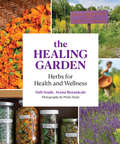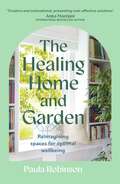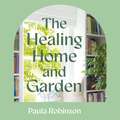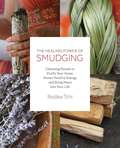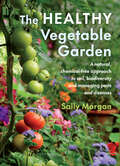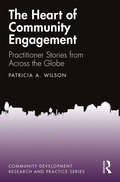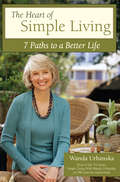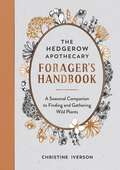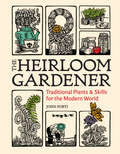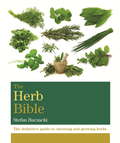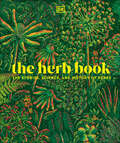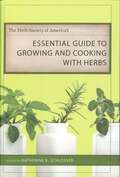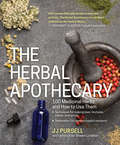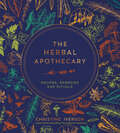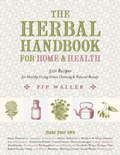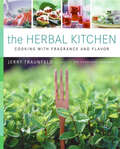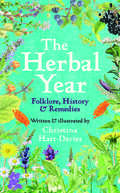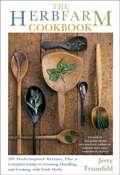- Table View
- List View
The Healing Garden: Herbal Plants for Health and Wellness
by Deb SouleIn The Healing Garden, Deb Soule, founder of Avena Botanicals, offers an inspiring guide to herb gardening and crafting herbal remedies that promote wellness of spirit and body. Soule combines her passion for plants gardens, and healing with her extensive experience working with medicinal herbs, flowers, roots, and berries. Her practical advice addresses each aspect of fostering a garden filled with helpful, healing plants: biodynamic gardening practices; gathering plants and setting up a drying room; and creating herbal teas, decoctions, tinctures, syrups, tonics, vinegars, essences, and more. A chapter outlining eighteen medicinal herbs provides detailed information on their cultivation and healing properties. Molly Haley's colorful photography showcases Avena Botanicals' lush herb gardens in all seasons. The Healing Garden is grounded in respect for the interconnectedness of all living beings and is an eloquent plea for spiritual awareness and the wholeness of individuals, communities, and our planet.
The Healing Home and Garden: Reimagining spaces for optimal wellbeing
by Paula RobinsonAre you tired of formulaic interiors and following trends? Do you long for a home that expresses who you truly are, that's a sanctuary from our 24/7 lifestyles dominated by technology?The Healing Home & Garden will help you to:- Take an objective look at your home - Examine whether it's supporting your mental and physical wellbeing - Identify how it may be perpetuating unhealthy habits like: working all hours, eating on the run, poor sleep and spending too much time indoors - Tap into your intuition to create a healing environment that will ultimately make you happier, less stressed and healthier - Reconnect with the restorative power of natureThe Healing Home & Garden is for everyone - no matter your budget, whether you rent or own, live in a bedsit or a mansion. No major building works are involved, just a call to follow your own intuition and create the home that's right for you - not the style police! This book is full of budget tips for rethinking your living space, creative suggestions for re-purposing furniture and objects, and extensive product and book recommendations."Paula Robinson is at the leading edge of new systems of awareness about the spaces we inhabit... a treasure trove of practical, step-by-step guidance"Jean Haner, author of Clear Home Clear Heart: Learn to Clear the Energy of People and Places
The Healing Home and Garden: Reimagining spaces for optimal wellbeing
by Paula RobinsonAre you tired of formulaic interiors and following trends? Do you long for a home that expresses who you truly are, that's a sanctuary from our 24/7 lifestyles dominated by technology?The Healing Home & Garden will help you to:- Take an objective look at your home - Examine whether it's supporting your mental and physical wellbeing - Identify how it may be perpetuating unhealthy habits like: working all hours, eating on the run, poor sleep and spending too much time indoors - Tap into your intuition to create a healing environment that will ultimately make you happier, less stressed and healthier - Reconnect with the restorative power of natureThe Healing Home & Garden is for everyone - no matter your budget, whether you rent or own, live in a bedsit or a mansion. No major building works are involved, just a call to follow your own intuition and create the home that's right for you - not the style police! This book is full of budget tips for rethinking your living space, creative suggestions for re-purposing furniture and objects, and extensive product and book recommendations."Paula Robinson is at the leading edge of new systems of awareness about the spaces we inhabit... a treasure trove of practical, step-by-step guidance"Jean Haner, author of Clear Home Clear Heart: Learn to Clear the Energy of People and Places
The Healing Home and Garden: Reimagining spaces for optimal wellbeing
by Paula RobinsonAre you tired of formulaic interiors and following trends? Do you long for a home that expresses who you truly are, that's a sanctuary from our 24/7 lifestyles dominated by technology?The Healing Home & Garden will help you to:- Take an objective look at your home - Examine whether it's supporting your mental and physical wellbeing - Identify how it may be perpetuating unhealthy habits like: working all hours, eating on the run, poor sleep and spending too much time indoors - Tap into your intuition to create a healing environment that will ultimately make you happier, less stressed and healthier - Reconnect with the restorative power of natureThe Healing Home & Garden is for everyone - no matter your budget, whether you rent or own, live in a bedsit or a mansion. No major building works are involved, just a call to follow your own intuition and create the home that's right for you - not the style police! This book is full of budget tips for rethinking your living space, creative suggestions for re-purposing furniture and objects, and extensive product and book recommendations."Paula Robinson is at the leading edge of new systems of awareness about the spaces we inhabit... a treasure trove of practical, step-by-step guidance"Jean Haner, author of Clear Home Clear Heart: Learn to Clear the Energy of People and Places
The Healing Power of Smudging: Cleansing Rituals to Purify Your Home, Attract Positive Energy and Bring Peace into Your Life
by Rodika TchiA DIY guide to cleansing your home of negative energy with the power of the ancient art of smudging—includes photos. Invite happiness and power into your life! Sharing the ancient tradition of space clearing with sacred smoke, this comprehensive introduction to smudging teaches you how to empower your life, your home, and your heart. With step-by-step tutorials, colorful photos, and expert advice, this book makes it easy to: • Smudge your home, yourself, and others • Craft your own smudge stick and fan • Choose sacred herbs, oils, and resins • Select the ideal day and time to smudge • Add crystals to your smudging alter • Perform rituals for all occasions
The Healthy Vegetable Garden: A natural, chemical-free approach to soil, biodiversity and managing pests and diseases
by Sally MorganWhether you’re an experienced gardener, homesteader, or market farmer, this A–Z, soil-to-table guide shows you how to reduce chemical inputs; naturally enrich your growing ecology; and create a hardy, nutrient-dense, and delicious crop. "There are few gardeners (or farmers) I know who wouldn’t benefit from reading Sally Morgan’s new book. . . . The Healthy Vegetable Garden is a detailed and indispensable resource."—Hobby Farms In The Healthy Vegetable Garden, expert organic gardener Sally Morgan explains how to use natural approaches to cope with the challenges of a changing climate through principles from regenerative gardening, agroecology, and permaculture—all to help your green space thrive. The Healthy Vegetable Garden shows you how to: Combat disease and keep pests at bay with natural predators, companion planting, and trap and barrier crops Choose the right plants to attract pollinators and pest predators Build a healthy soil full of organic matter, earthworms, and mycorrhizal fungi Regenerate soil through no-dig practices, composting, cover crops, and mulching Boost biodiversity through the use of crop rotations and polyculture Rewild your garden by creating a range of habitats, making use of walls and fences, log piles, water features, and wild corners Understand plant defenses and use biocontrols Make natural barriers, traps, and lures A healthy, productive garden should work in harmony with nature to produce and protect delicious fruits and vegetables and build a rich soil that is full of life. With The Healthy Vegetable Garden, growers of all levels will start reducing incidents of pests and diseases while creating a verdant habitat—all without the need for fertilizers, pesticides, or weedkillers.
The Healthy Vegetable Garden: A natural, chemical-free approach to soil, biodiversity and managing pests and diseases
by Sally MorganWhether you&’re an experienced gardener, homesteader, or market farmer, this A–Z, soil-to-table guide shows you how to reduce chemical inputs; naturally enrich your growing ecology; and create a hardy, nutrient-dense, and delicious crop."There are few gardeners (or farmers) I know who wouldn&’t benefit from reading Sally Morgan&’s new book. . . . The Healthy Vegetable Garden is a detailed and indispensable resource."—Hobby Farms In The Healthy Vegetable Garden, expert organic gardener Sally Morgan explains how to use natural approaches to cope with the challenges of a changing climate through principles from regenerative gardening, agroecology, and permaculture—all to help your green space thrive.The Healthy Vegetable Garden shows you how to:• Combat disease and keep pests at bay with natural predators, companion planting, and trap and barrier crops• Choose the right plants to attract pollinators and pest predators• Build a healthy soil full of organic matter, earthworms, and mycorrhizal fungi• Regenerate soil through no-dig practices, composting, cover crops, and mulching• Boost biodiversity through the use of crop rotations and polyculture• Rewild your garden by creating a range of habitats, making use of walls and fences, log piles, water features, and wild corners• Understand plant defenses and use biocontrols• Make natural barriers, traps, and luresA healthy, productive garden should work in harmony with nature to produce and protect delicious fruits and vegetables and build a rich soil that is full of life. With The Healthy Vegetable Garden, growers of all levels will start reducing incidents of pests and diseases while creating a verdant habitat—all without the need for fertilizers, pesticides, or weedkillers.
The Heart of Community Engagement: Practitioner Stories from Across the Globe (Community Development Research and Practice Series)
by Patricia A. WilsonDrawing on first-hand accounts of action research in the Americas, Africa, and Asia, The Heart of Community Engagement illustrates the transformative learning journeys of exemplary catalysts for community-based change. Practitioners’ stories of community engagement for social justice in the Global South elucidate the moments of insight and transformation that deepened their practice: how to deal with uncertainty, recognize their own blind spots, become aware of what is emergent and possible in the moment, and weave an inclusive bond of love, respect, and purpose. Each successive narrative adds a deeper level of understanding of the inner practice of community engagement. The stories illuminate the reflective, or inner, practice of the outside change agent, whether a planner, designer, participatory action researcher, or community development practitioner. From a shantytown in South Africa, to a rural community in India, or an informal settlement in peri-urban Mexico, the stories focus attention on the greatest leverage point for change that we, as engaged practitioners, have: our own self-awareness. By the end of the book, the practitioners are not only aware of their own conditioned beliefs and assumptions, but have opened their minds and hearts to the complex and dynamic patterns of emergent change that is possible. This book serves as a much-needed reader of practice stories to help instructors and students find the words, concepts, and examples to talk about their own subjective experience of community engagement practice. The book applies some of the leading-edge concepts from organizational development and leadership studies to the fields of planning, design, and community engagement practice. Key concepts include the deep dive of sensing the social field, seeing the whole, and presencing the emergent future. The book also provides a creative bridge between participatory action research and design thinking: user-based design, rapid prototyping, and learning from doing.
The Heart of Simple Living: 7 Paths to a Better Life
by Wanda UrbanskaThe Heart of Simple Living is your road map to a more balanced life - a life centered on self-discovery. Fewer possessions. More time. More friends. More meaning. This book will help you identify objectives for your life and create awareness of your actions and finances, while planning for your future.This inspirational book delivers seven tangible and actionable paths, woven together with real-life stories and humor along the way. You can follow these paths sequentially or cherry-pick them one at a time. Pursuing a life of simplicity is a journey, and as you blaze the trail to your simple life, celebrate the magic and joy of family, ritual and community - the perfect prescription for essential good health and well-being.
The Hedgerow Apothecary Forager's Handbook: A Seasonal Companion to Finding and Gathering Wild Plants
by Christine IversonLearn to forage in the hedgerows like the herbalists of the pastAs many of us look for ways to live a more planet-friendly lifestyle, the sustainable and ethical art of foraging offers us a way to connect with the world around us. It is a practice rich in tradition and steeped in history, and one that links us to our past and our future.This foraging companion is designed to be taken with you on your adventures into the hedgerows, forests and woodland all year round. Helpfully arranged by season, this book includes clear photographs to aid plant identification, ideas on how best to prepare and preserve your finds, fascinating foraging and plant folklore, and handy pages to make your own notes and drawings.Additional features:- A month-by-month foraging calendar- Advice on foraging etiquette and tips for creating a forager's toolkitThis is the essential guide to enjoying the bountiful delights of the hedgerows.
The Heirloom Gardener: Traditional Plants and Skills for the Modern World
by John Forti&“Empowers readers with a toolkit of traditional and sustainable practices for an emerging artisanal crafts movement, and a brighter future.&” —Alice Waters, chef and owner, Chez Panisse; founder, The Edible Schoolyard Project Modern life is a cornucopia of technological wonders. But is something precious being lost? A tangible bond with our natural world—the deep satisfaction of connecting to the earth that was enjoyed by previous generations? In The Heirloom Gardener, John Forti celebrates gardening as a craft and shares the lore and traditional practices that link us with our environment and with each other. Charmingly illustrated and brimming with wisdom, this guide will inspire you to slow down, recharge, and reconnect.
The Herb Almanac: A seasonal guide to medicinal plants
by Chelsea Physic GardenA beautiful and accessible seasonal guide to herbalism from the historic botanic garden.Discover the best times of the year for growing specific healing herbs and also when and how to forage for wild medicine, such as water mint, St John's Wort, hawthorn berries and rosehips. Recipes are included for how to use these herbs, along with folklore stories from herb wives and hedge witches, the meanings behind their names and the history of how these natural medicines were discovered.There are plenty of tips for how to create your own medicinal herb garden, even with just a few pots, along with a biodynamic guide for sowing, planting and harvesting. Including detailed hand-drawn line illustrations to help deepen your understanding, The Herb Almanac is the perfect gift for any nature lover.CONTENTS INCLUDES:IntroductionIncluding using herbs as seasonally appropriate remedies and tonics, an overview of herbs in folklore, wild medicine, magic, superstition, ritual, tradition and literature and herbs in religion and floriography (the language of flowers)Gathering and Using HerbsIncluding safe, legal and successful foraging, a brief introduction to growing your own herbs and preparing, drying and preserving herbsWitches' Brews: Poisonous Plants Including an overview of herbs with interesting stories that cannot be easily used, e.g. wormwood, hemlock and mandrakeHerb EncyclopediaIncluding detailed information on over 50 different herbs
The Herb Almanac: A seasonal guide to medicinal plants
by Chelsea Physic GardenA beautiful and accessible seasonal guide to herbalism from the historic botanic garden.Discover the best times of the year for growing specific healing herbs and also when and how to forage for wild medicine, such as water mint, St John's Wort, hawthorn berries and rosehips. Recipes are included for how to use these herbs, along with folklore stories from herb wives and hedge witches, the meanings behind their names and the history of how these natural medicines were discovered.There are plenty of tips for how to create your own medicinal herb garden, even with just a few pots, along with a biodynamic guide for sowing, planting and harvesting. Including detailed hand-drawn line illustrations to help deepen your understanding, The Herb Almanac is the perfect gift for any nature lover.CONTENTS INCLUDES:IntroductionIncluding using herbs as seasonally appropriate remedies and tonics, an overview of herbs in folklore, wild medicine, magic, superstition, ritual, tradition and literature and herbs in religion and floriography (the language of flowers)Gathering and Using HerbsIncluding safe, legal and successful foraging, a brief introduction to growing your own herbs and preparing, drying and preserving herbsWitches' Brews: Poisonous Plants Including an overview of herbs with interesting stories that cannot be easily used, e.g. wormwood, hemlock and mandrakeHerb EncyclopediaIncluding detailed information on over 50 different herbs
The Herb Bible: The Definitive Guide To Choosing And Growing Herbs
by Stefan BuczackiDiscover more than 130 herbs in this authoritative and attractive reference book by horticultural expert Stefan Buczacki. There is at-a-glance information on a wide range of herbs with advice on how to grow them and their best uses - both culinary and ornamental. Designing and planning a herb garden is also considered, with advice on site, soil and style.
The Herb Bible: The definitive guide to choosing and growing herbs
by Dr Stefan BuczackiDiscover more than 130 herbs in this authoritative and attractive reference book by horticultural expert Stefan Buczacki. There is at-a-glance information on a wide range of herbs with advice on how to grow them and their best uses - both culinary and ornamental. Designing and planning a herb garden is also considered, with advice on site, soil and style.
The Herb Book: The Stories, Science, and History of Herbs
by DKImmerse yourself in stories and pictures of these useful plants, from herb gardens to remote wildernesses. Herbs have been used by humans throughout history – for cooking, medicine, rituals, and more. They are also a huge part of the modern world, from gardening, food, and cosmetics to medicines fighting diseases such as malaria. With vibrant illustrations and expert knowledge, The Herb Book takes a close-up look at a wide range of herbs from around the world, showcasing their botanical characteristics, medicinal, cosmetic, and culinary properties and uses, and cultural impact on the lives of humans. Dive deep into the pages of this horticultural handbook to discover: - Detailed original photography combines with historical and contemporary images to create a compelling visual mix.- Provides a global view of herbs and their culinary, medicinal, and cosmetic uses around the world.- Contains in-depth coverage of over 80 herb species.- Continues the warm visual aesthetic of The Tree BookFeaturing key scientific facts along with historical and mythological stories, this book provides a rich blend of information on these extraordinary plants and their role in our world. Proving a must-have volume for gardeners, horticulturalists, and amateur herbalists alike, as well as anyone interested in natural remedies, cooks and foodies too!
The Herb Society of America's Essential Guide to Growing and Cooking with Herbs: A Novel (Voices of the South)
by Katherine K. SchlosserFresh herbs offer a healthy and delicious way to spice up any meal, but growing and cooking with these delectable plants are endeavors fraught with uncertainty. What herbs will grow year-round on my kitchen windowsill? What foods complement rosemary? Which part of a lemongrass plant has the best flavor? Can I really eat the geraniums growing in my flower bed? This indispensable guide from The Herb Society of America takes the guesswork out of using herbs in the garden and in the kitchen by providing detailed information for cultivating a wide variety of herbs, along with easy-to-follow recipes that will surely impress even the most discerning palate. Ranging from Alliums (onions, chives, and garlic) to Zingiber (ginger), the volume's first section provides horticultural information for each of the sixty-three herbs found in the National Herb Garden's Culinary Garden, including common and botanical names, family, place of origin, hardiness, and general light and soil requirements. Botanical sketches accompany many of the entries. Each entry also includes a short history of the herb, gardening basics, and suggestions for using the herb in your kitchen. Culinary herbs without Generally Recognized as Safe (GRAS) Status are included in a separate section, with an explanation of their history and ornamental value. An informative introduction to this section compares several different definitions of the word herb, explains the advantages of fresh over dried herbs, describes the proper storage and use of spices, and suggests the best timing and methods for harvesting herbs. In the second part of the book, HSA members offer classic and creative recipes for more than two hundred dishes incorporating a variety of herbs. Learn how to use the aromatic and flavorful herbs in your garden to enhance stews and casseroles, create dips and pestos, and add a new dimension to your favorite liqueurs. Among the mouth-watering recipes featured are Lemon Basil Tea Bread, Chicken Linguine with Fennel and Tarragon, Five-Herb Pasta Salad, and Rosemary Fizz.The concluding section of the book contains a fascinating personal tour of the two-and-one-half-acre National Herb Garden, which lies in the heart of Washington, D.C., at the center of the United States National Arboretum, and of its various themed areas, including the Knot Garden, the Antique and Heritage Rose Garden, the Dye Garden, the Colonial Garden, the Native American Garden, the Beverage Garden, the Medicinal Garden, and many others. Complete plant lists accompany the description of each garden.Green thumbs and gourmets alike will find inspiration in these pages to look at herbs in new ways -- perhaps to see beyond their cupboards and into their own yards for ways to liven up their meals -- and will gain the knowledge and confidence to grow and use herbs effectively. More than a gardening book, more than a cookbook, The Herb Society of America's Essential Guide to Growing and Cooking with Herbs will prove to be an indispensable companion for all herb lovers.
The Herbal Apothecary: 100 Medicinal Herbs and How to Use Them
by Jj Pursell“A brilliant addition to any library.” —Rosemary Gladstar, herbalist and bestselling author More and more people are exploring the healing possibilities of plant-based medicines, and health shops across the country now stock their shelves with natural remedies, but treatments can easily be made at home. The Herbal Apothecary profiles 100 of the most important medicinal plants with striking photographs and step-by-step instructions for making herbal teas, tinctures, compresses, and salves to treat everything from muscle strain to the common cold or anxiety. This holistic guide also includes advice for the home gardener on growing and foraging for medicinal plants. Incorporating traditional wisdom and scientific information, The Herbal Apothecary provides an accessible and comprehensive introduction to plant-based medicine. With the guidance of naturopath JJ Pursell, herb enthusiasts can learn how to safely create their own remedies using plants they know and love.
The Herbal Apothecary: Recipes, Remedies and Rituals
by Christine IversonFrom the best-selling author of The Hedgerow Apothecary, The Garden Apothecary and The Hedgerow Apothecary Forager's Handbook Learn the sustainable and ethical art of the apothecarist with this beautiful photographic guide to working with herbs and spices to make healing remedies and delicious recipes. Discover the fascinating properties and therapeutic benefits of everyday ingredients found in herb gardens and kitchen cupboards. For centuries, herbalists and healers have looked to nature for remedies and have made salves, toddies, teas, balms and preserves as cures for common ailments and to add piquant aromas and flavours to dishes - and now you can too. Inside you will find:- Photographs to help you safely identify edible plants - Advice on what is available in each season - Guidance on how best to grow, prepare and preserve your herbs and spices - Useful herbal remedies and delicious recipes to try - The fascinating folklore and history of these majestic aromatic plants
The Herbal Apothecary: Recipes, Remedies and Rituals
by Christine IversonFrom the best-selling author of The Hedgerow Apothecary, The Garden Apothecary and The Hedgerow Apothecary Forager's Handbook Learn the sustainable and ethical art of the apothecarist with this beautiful photographic guide to working with herbs and spices to make healing remedies and delicious recipes. Discover the fascinating properties and therapeutic benefits of everyday ingredients found in herb gardens and kitchen cupboards. For centuries, herbalists and healers have looked to nature for remedies and have made salves, toddies, teas, balms and preserves as cures for common ailments and to add piquant aromas and flavours to dishes - and now you can too. Inside you will find:- Photographs to help you safely identify edible plants - Advice on what is available in each season - Guidance on how best to grow, prepare and preserve your herbs and spices - Useful herbal remedies and delicious recipes to try - The fascinating folklore and history of these majestic aromatic plants
The Herbal Handbook for Home and Health
by Pip WallerKitchen pharmacy meets green cleaning and natural beauty in this comprehensive handbook of 501 recipes that harness the power of plants to enhance wellness and toxin-free living. Expert herbalist Pip Waller provides a wealth of information about growing, collecting, preserving, and preparing herbs for a variety of purposes--from cleaning products, to food and drink, medicines, beauty products, and more. Attractive and easy to use, The Herbal Handbook for Home and Health includes growing tips and profiles of herbs, guidelines for setting up an herbalist's kitchen, and techniques to make everything from tinctures to tonics. A valuable resource for anyone affected by allergies or sensitivities, this compendium is handsomely produced with two-color printing throughout and more than three hundred striking illustrations.The Handbook includes contributions from herbalists from around the world and encompasses recipes that range from very simple to more complex. Seasoned herbalists as well as those just beginning to explore the world of herbs will find something to start their own nontoxic, non-allergenic domestic revolution.The book includes: * A history of herbal lore * The herbalist's kitchen--equipment and procedures for harnessing the power of plants * Green cleaning products (from floor wax to stain removers) * Herbal pharmacy (from throat lozenges to hangover cures) * Nutritional supplements and detoxes * First aid (from anti-anxiety drops to bruise ointment) * For travel (insect repellant to anti-nausea drops) * Food and drink (breads, butters, wines, teas) * Beauty and balms (toothpaste to shampoo to lip balm) * Kitchen Pharmacy * Food & Drink * Beauty, Balms & Personal Care
The Herbal Home Spa: Naturally Refreshing Wraps, Rubs, Lotions, Masks, Oils, and Scrubs
by Greta BreedloveThis book tells all about how to make easy, affordable, and effective herbal spa treatments at home. Covers treatments for the hair, scalp, skin, cosmetics, body lotions and wraps, and more. Gives hints on where to find the ingredients, basic uses of herbs and other ingredients, and hints on ways to "tweak" the recipes to make them totally personalized to your needs and for gift giving.
The Herbal Kitchen: Cooking with Fragrance and Flavor
by Jerry TraunfeldThe secret to transforming easy dishes into extraordinary meals? Fresh herbs. In The Herbal Kitchen, IACP award-winning cookbook author and acclaimed Herbfarm Restaurant chef Jerry Traunfeld presents simple dishes using herbs straight from the market, windowsill, or garden.Until recently, the fresh herbs available in supermarkets were limited to parsley and maybe dill. Today, thyme, rosemary, basil, cilantro, mint, and sage are among the many fresh herbs as close as the produce section or the farmer's market. Not to mention marjoram, lovage, tarragon, lavender, shiso, and so many others.Jerry shows you how to incorporate these fresh herbs into your everyday home meals. So whether preparing a workday supper for the family, a special dinner for two or four, or a feast for a table of guests, using fresh herbs in your cooking will result in fresh and vibrant food.The Herbal Kitchen includes some recipes that are home variations of the innovative dishes Jerry prepares at the Herbfarm, while others are fresh takes on familiar classics such as Herb Garden Lasagna or Shrimp in Garlic-Sage Butter. All are uncomplicated and prep time is minimal -- with the emphasis on spontaneity and the unmistakable flavors of fresh herbs.Start off with Asparagus and Lemon Thyme Soup, Spicy Verbena Meatballs, or Rye-Thyme Cheese Straws before moving on to Cinnamon Basil Chicken, Side of Salmon Slow-Roasted in Dill, and Root Ribbons with Sage. Delectable desserts include Warm Lavender Almond Cakes, Rhubarb Mint Cobbler, and a sinful Chocolate Peppermint Tart.Once you're hooked on cooking with fresh herbs, you'll want to grow them yourself. The Herbal Kitchen is filled with important tips for growing, harvesting, and handling each of the herbs used in the recipes. Valuable information on the varieties of each herb is also highlighted, such as how to tell the difference between Greek oregano and Italian oregano, why you always want to choose bay laurel over California bay, and what type of lavender is best for cooking.Filled with stunning photos of the herbs, the techniques for handling them, and the finished dishes, Jerry's definitive guide is sure to be a classic, reached for again and again.
The Herbal Year: Folklore, History and Remedies
by Christina Hart-DaviesAn enchanting, beautifully illustrated guide to seasonal plants—showing the long history of herbal remedies and their uses today“[A] charming almanac. . . . Hart-Davies, a writer and botanical illustrator whose watercolors enliven her book, . . . offers a lively combination of folk history and modern science; they overlap in intriguing ways.”—Priscilla M. Jensen, Wall Street Journal From sweet violets in spring to rosemary in winter, via marigolds, sage, elderberries, and hops, every season has its own bounty of herbs and plants. Christina Hart-Davies presents a delightful guide to common plants as they appear throughout the year. Drawing on writers, storytellers, and poets from across the centuries, she examines the long history of herbal remedies. She shows how plants have been used for healing and unearths the stories and beliefs that surround them—including simple recipes for use at home. Fully illustrated with exquisitely detailed watercolours, this is an inspirational guide to exploring our age-old relationship with plants. Readers will discover the hidden secrets of the plants that surround us and, through this, will be able to reconnect with our place in nature. We have relied on plants throughout our history. We still do, and, with luck, we always will.
The Herbfarm Cookbook
by Jerry TraunfeldNot so long ago, parsley was the only fresh herb available to most American cooks. Today, bunches of fresh oregano and rosemary can be found in nearly every supermarket, basil and mint grow abundantly in backyards from coast to coast, and garden centers offer pots of edible geraniums and lemon thyme. But once these herbs reach the kitchen, the inevitable question arises: Now what do I do with them? Here, at last, is the first truly comprehensive cookbook to cover all aspects of growing, handling, and cooking with fresh herbs.Jerry Traunfeld grew up cooking and gardening in Maryland, but it wasn't until the 1980s, after he had graduated from the California Culinary Academy and was working at Jeremiah Tower's Stars restaurant in San Francisco, that he began testing the amazing potential of herb cuisine. For the past decade, Jerry Traunfeld has been chef at The Herbfarm, an enchanted restaurant surrounded by kitchen gardens and tucked into the rainy foothills of the Cascade Mountains, east of Seattle. His brilliant nine-course herb-inspired menus have made reservations at the Herbfarm among the most coveted in the country. Eager to reveal his magic to home cooks, Jerry Traunfeld shares 200 of his best recipes in The Herbfarm Cookbook. Written with passion, humor, and a caring for detail that makes this book quite special, The Herbfarm Cookbook explains everything from how to recognize the herbs in your supermarket to how to infuse a jar of honey with the flavor of fresh lavender. Recipes include a full range of dishes from soups, salads, eggs, pasta and risotto, vegetables, poultry, fish, meats, breads, and desserts to sauces, ice creams, sorbets, chutneys, vinegars, and candied flowers. On the familiar side are recipes for Bay Laurel Roasted Chicken and Roasted Asparagus Salad with Fried Sage explained with the type of detail that insures the chicken will be moist and suffused with the flavor of bay and the asparagus complemented with the delicate crunch of sage. On the novel side you will find such unusual dishes as Oysters on the Half Shell with Lemon Varbana Ice and Rhubarb and Angelica Pie. A treasure trove of information, The Herbfarm Cookbook contains a glossary of 27 of the most common culinary herbs and edible flowers; a definitive guide to growing herbs in a garden, a city lot, or on a windowsill; a listing of the USDA has hardiness zones; how to harvest, clean, and store fresh herbs; a Growing Requirements Chart, including each herb's life cycle, height, pruning and growing needs, and number of plants to grow for an average kitchen; and a Cooking with Fresh Herbs Chart, with parts of the herb used, flavor characteristics, amount of chopped herb for six servings, and best herbal partners. The Herbfarm Cookbook is the most complete, inspired, and useful book about cooking with herbs ever written. -8 pages of finished dishes in full color -16 full-page botanical watercolors in full color
